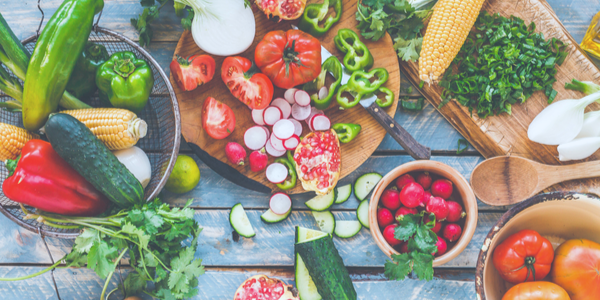
A new, usually fad diet seems to emerge at least monthly. Promising to be the best weight loss plan, most of these diets fail because they are not maintainable and too restrictive.
However, every once in a while, a more promising diet better referred to as a dietary pattern infiltrates Google. Such is the case with a new diet plan called The Engine 2 diet.
Allow this to serve as a comprehensive guide for optimizing the Engine 2 diet meal plan.
What Is the Engine 2 Diet?
Created by former professional triathlete and firefighter, Rip Esselstyn, the Engine 2 diet is based on the book, "The Engine 2 Seven-Day Rescue Diet," which offers comprehensive information and guidelines for the diet. The Seven-Day Rescue Plan is basically a stricter version of the Engine 2 diet designed to achieve quicker (but likely not lasting) results.
The Engine 2 diet is a low-fat eating pattern that emphasizes plant-based and nutrient-dense foods like fruits, vegetables, whole grains, and legumes. No animal products are included in the meal plan and it is also SOS-free - salt, oil, and sugar-free. In addition to these diet modifications, the overall plan also encourages regular exercise and staying adequately hydrated throughout the day.
Proponents claim that, unlike other trendy diets, Engine 2 removes the aim of quick weight loss. Instead, it promotes long-term health intended to protect against chronic diseases like high cholesterol, cardiovascular disease, metabolic syndrome, and diabetes.
The creators and other proponents suggest Engine 2 is ideal for athletes, pregnant or nursing women, and adults who are already at a healthy weight.
So, how does it work?
Engine 2 Diet Meal Plan
Most diets simply rely on caloric or macronutrient restriction to exert their purported effects. So, it’s refreshing that the Engine 2 diet focuses on the inclusion of nutrient-dense foods and does not require tracking calories, macros, or specific nutrients - although it is considered low-fat by nature.
The plant-based diet plan supports eating three main meals per day, with the option for snacks as long as they follow the same guidelines as the meals.
Unlimited fruits, vegetables, whole grains, and legumes are permitted. Small amounts of nut butters, tofu, tempeh, seitan, smoothies, and plant-based baked goods and milks are also allowed in moderation.
Conversely, all animal products, vegetable oils, and refined or processed foods are not permitted. Moreover, some typical healthy foods like avocados, nuts (except walnuts), seeds, and dried fruit are also supposed to be avoided or limited in this diet plan.
The diet is naturally free of common allergens like dairy, eggs, and shellfish. However, it still includes typical ones like soy, gluten, and some tree nuts, though the former ones can be omitted.
Because this is a fairly restrictive style of eating, especially for those acquainted with the standard American diet, there is an available online meal planner. The planner creates Engine 2 diet recipes, personalized meal recommendations, and grocery lists for an additional cost of $14 per month or $99 per year.
Furthermore, an entire line of Engine 2-friendly meals and foods are available at Whole Foods Market. It includes compliant cereal, veggie burgers, plant milk, vegetable stock, granola, soup, hummus, pasta, burritos, and more. However, this line of food is considered comparatively expensive.
Overall Review of the Engine 2 Diet
All in all, the Engine 2 diet is a stricter version of veganism and the macrobiotic diet. It excludes healthy fats like olive oil, avocado, nuts, and seeds, but is more liberal than the raw food diet or fruitarian diet.
The emphasis on plant foods and low animal intake offers some health benefits, especially the risk reduction of cardiovascular disease and colon cancer. However, it is certainly not a fool-proof diet and may not be maintainable for a large majority.
But let us dive deeper into the potential pros and cons of the Engine 2 diet.
Pros of the Engine 2 Diet
Most "hip" diets tend to fall short of benefits but the Engine 2 diet does offer a silver lining by focusing on whole foods and not on meticulous counting - amongst others!
Whole Foods First
The diet omits all processed and refined foods and only permits nutrient-dense whole foods. This is the single best way to optimize metabolism and reduce the risk of chronic and autoimmune diseases. This is because whole foods include necessary micronutrients, fiber, and other polyphenols like antioxidants and beneficial enzymes.
Heart-Healthy
Interestingly, the engine diet was initially created to assist fellow firefighters in lowering their cholesterol levels. The inclusion of many high-fiber plants and the exclusion of animal products greatly reduces the risk for cardiovascular disease and related conditions like high blood pressure, diabetes, and obesity.
No Counting
Once again, because the diet is whole foods-based, there is less need to focus on counting arbitrary values like calories or macros. The body perceives, digests, and absorbs whole food nutrients differently than processed and refined food products.
Overall, with a high intake of whole foods, the body is better able to naturally regulate hunger and fullness cues, cravings, and overall energy intake to promote a healthy weight.
Weight Loss
Though the emphasis of Engine 2 is not weight loss, it may be suitable enough for some to lose weight. The whole foods, high fiber, and colorful nature of the diet may promote weight loss in those who need to lose weight.
In addition, because the body prefers whole foods, this diet will naturally promote a healthy weight for your body. But because so restrictive, it could inadvertently promote too much weight loss in those who do not necessarily need or want to lose weight.
Drawbacks of the Engine 2 Diet
With all the pros, what's the catch? There are a few to note.
Low-Fat Promotion
Within the past 20 years or so, it is been well established that healthy fats do not contribute to weight gain. In fact, they are actually very heart and brain-healthy as well as anti-inflammatory.
While the Engine 2 diet omits the more inflammatory fats like trans and some saturated from animal products, it also avoids very nutritious fats like omega-3 fatty acids and monounsaturated fats.
In fact, including plenty of healthy fats is a cornerstone of most effective weight loss programs nowadays related to their blood sugar balancing effect.
Low Protein
Because the diet avoids all animal products and only permits small, occasional servings of soy-based protein like tofu, it is considered one of the lowest protein eating patterns on the market.
Protein requires the most energy to break down into usable energy and is very satiating, both of which typically promote weight loss. Now, the diet is upfront about removing the emphasis of weight loss, so perhaps this is not considered a true con for some people.
Nutrient Deficiencies
Protein, healthy fats, and even animal products provide specific nutrients that cannot be consumed from foods elsewhere. Because of the off-limit foods, the Engine 2 diet may be low in nutrients like protein, omega-3 fatty acids, vitamin B12, iron, folate, vitamin D, magnesium, and selenium.
Nutrient deficiencies can slow metabolism as well as create additional health problems.
Restrictive
Finally, the Engine 2 diet is extremely restrictive in food choices. For this reason, it may not be sustainable.
Additionally, omitting as many foods as the Engine 2 diet can backfire and increase cravings for off-limit foods. This can lead to cycles of restriction and binge eating, disordered eating patterns, or overt binge eating high sugar and high-fat foods.
In Summary
Designed with heart health at the forefront, the Engine 2 diet is a plant-based style eating plan that emphasizes reducing chronic disease risk and long-term health. While the heavy plant focus offers ample fiber and antiinflammatory micronutrients and likely reduces cardiovascular disease risk, it is quite restrictive and low in some beneficial nutrients like protein, omega-3 fatty acids, and B12.
Moreover, while it is hardly the worst diet available, the Engine 2 diet is basically just a stricter form of the vegan diet. The de-emphasis on weight loss is refreshing, but many other healthy but liberal dietary patterns are likely safer and more sustainable in the long run.
Finally, followers of this diet will likely need to invest in supplementation like a multivitamin and omega-3 + D3. Those with moderate to severe insulin resistance should think twice about this diet as it is very carb-heavy, though the carbs are healthful.
References:
Link R. Engine 2 Diet Review: Does It Work? Healthline. Written July 16, 2020. https://www.healthline.com/nutrition/engine-2-diet-review.
Muinos L. What Is the Engine 2 Diet? Pros, Cons, and What You Can Eat. Verywell Fit. Updated February 9, 2021. https://www.verywellfit.com/engine-2-diet-4685593.






